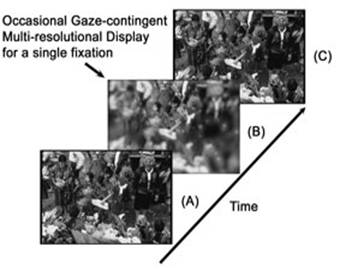The Limits of Visual Resolution in Natural Scene Viewing

When you look at a scene, you have very high acuity at the fovea (the center of vision), but your vision gets radically worse as retinal eccentricity (the distance from the center of vision) increases. Therefore, to develop theories of scene perception, we must know the limits of visual resolution across the visual field. For over 100 years, researchers have investigated how visual sensitivity decreases from the fovea to the visual periphery, generally using very simple stimuli and a fixed eye position. However, our research is among the first to investigate these questions using freely viewed natural scene images. We used a gaze-contingent multi-resolutional display and tested a model of retinal eccentricity-dependent contrast sensitivity. This study (Loschky, McConkie, Yang & Miller, 2005) provides the first estimate of the limits of visual resolution in free viewing of natural scenes. It provides important insights for theories of scene perception and a basis for predicting what information affects scene perception in different parts of the visual field.
